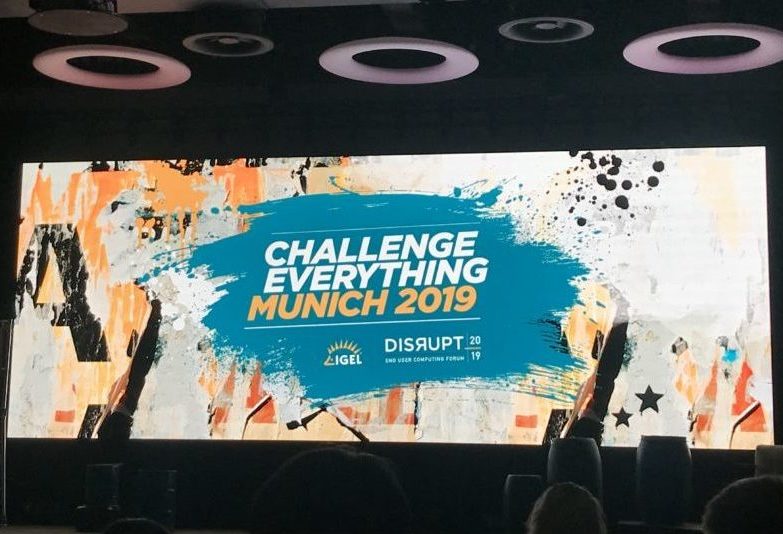First, a little history.
IGEL, similar to many tech companies, began life in an attic (the other popular room is the garage — think Apple); when the first piece of code was written by three friends over 15 years ago in Bremen, Germany.
Since it’s inception, the German-based software company is making waves in the end user computing (EUC) market — taking on Dell and HP in it’s pursuit of market dominance.
The organisation provides it’s customers with a platform, whereby they can access desktops and different applications in the cloud. As everyone knows, it’s now all about the move to the cloud and hence Desktop-as-a-Service.
“We’ve taken a significant market share, beating the biggest companies in the world,” said Jed Ayres, IGEL’s chief marketing officer, president and CEO of North America, during the opening of IGEL’s DISRUPT conference. “We’re redefining the category we belong to.”

Market drivers
So, what is driving the desktop-as-a-service (DaaS) demand for the end user computing market?
The big ‘one’ surrounds Windows 10. Organisations across the world — if they haven’t already — are in the process of moving from Windows 7 to Windows 10. The problem? Windows 10 can be vulnerable and increasingly difficult to manage since moving to the “as a Service” model. DaaS can help remove these challenges and offer a secure way to consume desktops and applications.
Other market drivers, such as the move Citrix is making to the cloud, the emergence of Amazon Workspaces and the more recently announced MS Windows Virtual Desktop are all playing their part.
What does all this mean? Well, business is moving into a software-defined era. They want the cloud, they no longer want to buy hardware, and if they have to, it has to be software-defined.
Putting this into the context of EUC, tradition is no longer viable. It needs to, and is evolving into a software-first proposition.
“By 2020, endpoint or EUC strategies that only focus on devices and internal cost optimisation activities will be replaced,” said Nathan Hill, VP research, Gartner. “Traditionally, EUC has been focused on PC imaging and hardware standards, but an increasing influx of devices and platforms has changed this. The traditional, device-approach doesn’t scale. There is now a need to use workplace analytics to adapt to employees, predict their needs and deliver better experiences.”
The future is hybrid
An increasing number of devices and platforms entering the workplace need to be scaled, and this is where DaaS comes in.

The slide speaks for itself.
In the evolution of end user computing, the future is hybrid: PC, virtual desktop infrastructure (VDI) and DaaS. It is increasingly difficult use one of these architectures by itself.
The PC platform has security challenges. Okay, so we bring in VDI to solve this (there is a deep penetration of this technology in sectors, such as financial services and healthcare. However, it is a complex and costly process. And, this is where DaaS comes in — the promise of the cloud; agility and utility.
But, as the slide shows, each platform has different strengths and weaknesses — so a combination, or hybrid approach for the workplace is needed.
Using desktop virtualisation to position your business for the future
The evolution of unified workspaces
According to Gartner, 40% of CEOs see growth as their number one business priority. CEOs expect that this growth should come from digital business initiatives that come from technology innovation — step up the CIOs and CTOs.
EUC in these digital-first businesses is spurring the evolution of unified workspaces, through different technologies and services. It provides a high viewpoint in digital business journey.
External inhibitors of growth are a lack of talent, cyber risks, inflexibility of technology and lack of investment.

Workspaces are changing. We are moving from the dominance of physical PCs and siloed work, to an open office, which prioritises innovation and fluidity.
This unified workspace will improve teamwork and individual productivity in the back drop of a sea of change. It will enable the ability to deliver the right content and data to the right people in the right place at the right time.
The rise of the frontline worker
In almost every business, the frontline, customer-facing worker is emerging, who is the ‘face’ of the business.
“If IT is supporting this worker, then IT is directly impacting the business and business outcomes,” said Hill.
“For example, within retail we’re moving away from fixed location point of sale: anywhere in the store, the shop assistant can take mobile payments. Smart mirrors are also emerging as a tech-tool to engage shoppers – those devices can provide measurements for the shop assistant. Retailers have to differentiate through experience.”
30% of IT mobile and endpoint resources will be dedicated to enabling frontline workers, up from 10% today — Gartner
“Investments in wearables, mobile technology and IoT are often speculative and not tied to an overarching business outcome strategy. Increasingly organisations approach to these new devices will mature and be driven by top-down investment,” continued Hill.
Indeed, new devices and wearables are entering the workspace that are in line with business drivers. But, this is a challenge for EUC ecosystems: new device types, operating systems and peripherals around that ecosystem.
As these new devices enter the workspace; how can businesses support these systems in a stable and secure manner, while supporting business outcomes and driving digital transformation?
“DaaS can leverage the diversity of platforms in your operation without scaling endpoint management challenges,” answered Hill.

Static, adaptive to continuous and contextual
The workspace strategy has evolved. It was static, where innovation primarily came through a hardware refresh.
It is now in what Hill calls “an adaptive phase, which represents a shift to software modernisation and innovation”.
Still, however, this transition to adaptive, creates a mixed experience if you try and traverse these platforms.
In this adaptive phase, DaaS and VDI are often conflated. VDI is a technology and DaaS is a service — an off-premise workspace on-demand via a provider. Here, the responsibility of security can be unclear: the customer, service provider, tooling provider or infrastructure platform provider?
As DaaS matures, price points are decreasing — Hill
A continuous and contextual experience — the next stage of the hype cycle after adaptive — is the future .

Some thoughts backed by stats
The arrival of the Windows Virtual desktop has validated DaaS, by pulling down licensing barriers and catalysed the growth of the service.
By 2023, 30% of todays on-premise VDI users will access a workspace in the cloud using DaaS.
The biggest driver of DaaS is the move to the cloud, the downsizing data centres and the consumption of cloud services; not just infrastructure to IaaS, but also the shift to Software-as-a-Service.
By 2022, 75% of organisations will form a digital workplace IT team to support end user computing needs.
Innovation at the heart of workspace transformation
Workspace analytics will drive innovation and transformation, by enabling the identification of new devices: monitoring them, assessing them and adapting to them.
Machine learning will play a huge role in this more pervasive analytics strategy, which will enable the next stage of continuous improvement.
Crucially, “no workplace analytics strategy will be effective if you don’t have same organisation-wide understanding and data governance in place,” said Hill. This will allow organisations to work in unison, with the same customer-driven goals. And, no more silos!
Non-technical roles are essential in enhancing the employee experience. And, vital in elevating the end user experience going forward
Change is coming
So, EUC, DaaS, the cloud — what does it all mean?
The journey to the cloud with DaaS and the new era of data governance requires a rethink of the organisational model.
What is this rethink? Organisations and entire industries need to move from endpoint and collaboration silos to endpoint and cloud office consolidation. And then, one stage further: to the future of end user computing — unified digital transformation teams.
The requirements of EUC have changed in the past and they will continue to change moving forward. DaaS will help smooth this transition.
“Are you ready for this change? It’s not easy, but an important to journey to go on,” concluded Hill.








